2010 NISSAN CUBE heater
[x] Cancel search: heaterPage 231 of 329
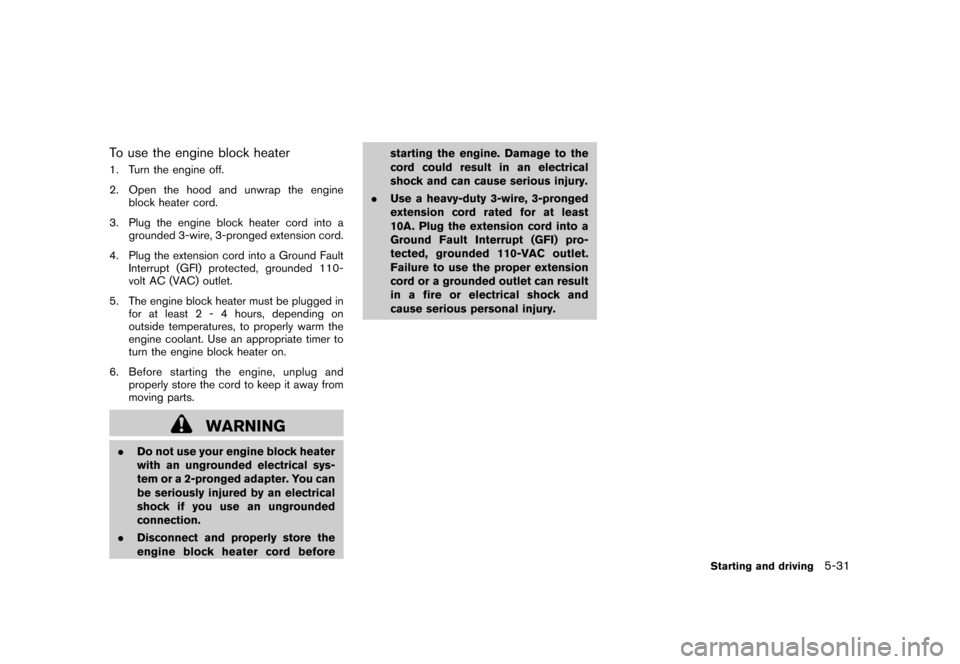
Black plate (235,1)
Model "Z12-D" EDITED: 2009/ 9/ 17
To use the engine block heater1. Turn the engine off.
2. Open the hood and unwrap the engineblock heater cord.
3. Plug the engine block heater cord into a grounded 3-wire, 3-pronged extension cord.
4. Plug the extension cord into a Ground Fault Interrupt (GFI) protected, grounded 110-
volt AC (VAC) outlet.
5. The engine block heater must be plugged in for at least 2 - 4 hours, depending on
outside temperatures, to properly warm the
engine coolant. Use an appropriate timer to
turn the engine block heater on.
6. Before starting the engine, unplug and properly store the cord to keep it away from
moving parts.
WARNING
.Do not use your engine block heater
with an ungrounded electrical sys-
tem or a 2-pronged adapter. You can
be seriously injured by an electrical
shock if you use an ungrounded
connection.
. Disconnect and properly store the
engine block heater cord before starting the engine. Damage to the
cord could result in an electrical
shock and can cause serious injury.
. Use a heavy-duty 3-wire, 3-pronged
extension cord rated for at least
10A. Plug the extension cord into a
Ground Fault Interrupt (GFI) pro-
tected, grounded 110-VAC outlet.
Failure to use the proper extension
cord or a grounded outlet can result
in a fire or electrical shock and
cause serious personal injury.
Starting and driving
5-31
Page 241 of 329
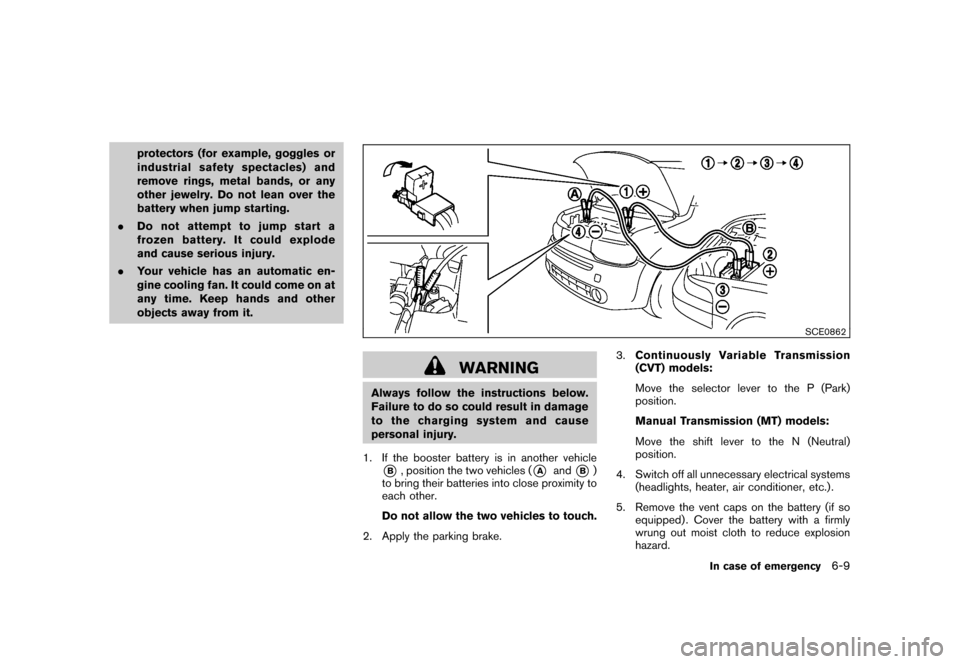
Black plate (245,1)
Model "Z12-D" EDITED: 2009/ 9/ 17
protectors (for example, goggles or
industrial safetyspectacles) and
remove rings, metal bands, or any
other jewelry. Do not lean over the
battery when jump starting.
. Do not attempt to jump start a
frozen battery. It could explode
and cause serious injury.
. Your vehicle has an automatic en-
gine cooling fan. It could come on at
any time. Keep hands and other
objects away from it.
SCE0862
WARNING
Always follow the instructions below.
Failure to do so could result in damage
to the charging system and cause
personal injury.
1. If the booster battery is in another vehicle*B, position the two vehicles (
*A
and
*B)
to bring their batteries into close proximity to
each other.
Do not allow the two vehicles to touch.
2. Apply the parking brake. 3.
Continuously Variable Transmission
(CVT) models:
Move the selector lever to the P (Park)
position.
Manual Transmission (MT) models:
Move the shift lever to the N (Neutral)
position.
4. Switch off all unnecessary electrical systems (headlights, heater, air conditioner, etc.) .
5. Remove the vent caps on the battery (if so equipped) . Cover the battery with a firmly
wrung out moist cloth to reduce explosion
hazard.
In case of emergency
6-9
Page 243 of 329
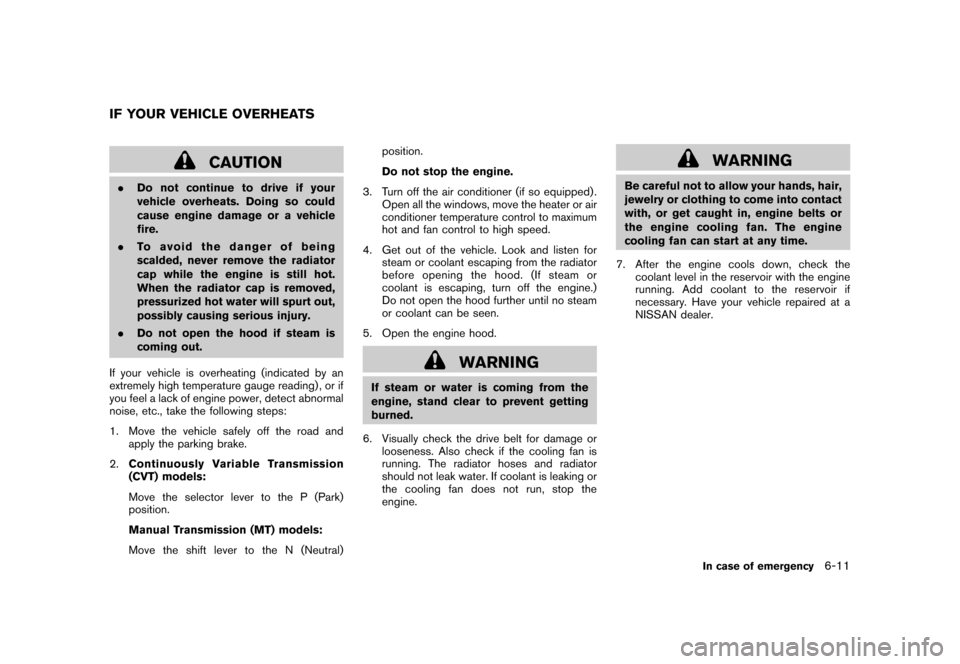
Black plate (247,1)
Model "Z12-D" EDITED: 2009/ 9/ 17
CAUTION
.Do not continue to drive if your
vehicle overheats. Doing so could
cause engine damage or a vehicle
fire.
. To avoid the danger of being
scalded, never remove the radiator
cap while the engine is still hot.
When the radiator cap is removed,
pressurized hot water will spurt out,
possibly causing serious injury.
. Do not open the hood if steam is
coming out.
If your vehicle is overheating (indicated by an
extremely high temperature gauge reading) , or if
you feel a lack of engine power, detect abnormal
noise, etc., take the following steps:
1. Move the vehicle safely off the road and apply the parking brake.
2. Continuously Variable Transmission
(CVT) models:
Move the selector lever to the P (Park)
position.
Manual Transmission (MT) models:
Move the shift lever to the N (Neutral) position.
Do not stop the engine.
3. Turn off the air conditioner (if so equipped) . Open all the windows, move the heater or air
conditioner temperature control to maximum
hot and fan control to high speed.
4. Get out of the vehicle. Look and listen for steam or coolant escaping from the radiator
before opening the hood. (If steam or
coolant is escaping, turn off the engine.)
Do not open the hood further until no steam
or coolant can be seen.
5. Open the engine hood.
WARNING
If steam or water is coming from the
engine, stand clear to prevent getting
burned.
6. Visually check the drive belt for damage or looseness. Also check if the cooling fan is
running. The radiator hoses and radiator
should not leak water. If coolant is leaking or
the cooling fan does not run, stop the
engine.
WARNING
Be careful not to allow your hands, hair,
jewelry or clothing to come into contact
with, or get caught in, engine belts or
the engine cooling fan. The engine
cooling fan can start at any time.
7. After the engine cools down, check the coolant level in the reservoir with the engine
running. Add coolant to the reservoir if
necessary. Have your vehicle repaired at a
NISSAN dealer.
IF YOUR VEHICLE OVERHEATS
In case of emergency
6-11
Page 262 of 329
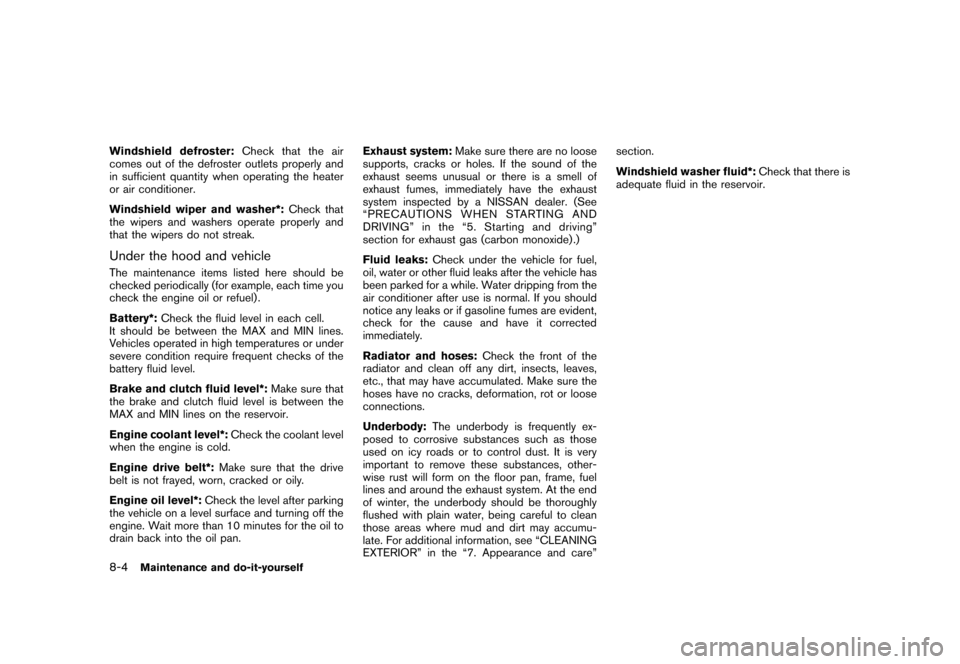
Black plate (266,1)
Model "Z12-D" EDITED: 2009/ 9/ 17
Windshield defroster:Check that the air
comes out of the defroster outlets properly and
in sufficient quantity when operating the heater
or air conditioner.
Windshield wiper and washer*: Check that
the wipers and washers operate properly and
that the wipers do not streak.Under the hood and vehicleThe maintenance items listed here should be
checked periodically (for example, each time you
check the engine oil or refuel) .
Battery*: Check the fluid level in each cell.
It should be between the MAX and MIN lines.
Vehicles operated in high temperatures or under
severe condition require frequent checks of the
battery fluid level.
Brake and clutch fluid level*: Make sure that
the brake and clutch fluid level is between the
MAX and MIN lines on the reservoir.
Engine coolant level*: Check the coolant level
when the engine is cold.
Engine drive belt*: Make sure that the drive
belt is not frayed, worn, cracked or oily.
Engine oil level*: Check the level after parking
the vehicle on a level surface and turning off the
engine. Wait more than 10 minutes for the oil to
drain back into the oil pan. Exhaust system:
Make sure there are no loose
supports, cracks or holes. If the sound of the
exhaust seems unusual or there is a smell of
exhaust fumes, immediately have the exhaust
system inspected by a NISSAN dealer. (See
“PRECAUTIONS WHEN STARTING AND
DRIVING” in the “5. St arting and driving”
section for exhaust gas (carbon monoxide) .)
Fluid leaks: Check under the vehicle for fuel,
oil, water or other fluid leaks after the vehicle has
been parked for a while. Water dripping from the
air conditioner after use is normal. If you should
notice any leaks or if gasoline fumes are evident,
check for the cause and have it corrected
immediately.
Radiator and hoses: Check the front of the
radiator and clean off any dirt, insects, leaves,
etc., that may have accumulated. Make sure the
hoses have no cracks, deformation, rot or loose
connections.
Underbody: The underbody is frequently ex-
posed to corrosive substances such as those
used on icy roads or to control dust. It is very
important to remove these substances, other-
wise rust will form on the floor pan, frame, fuel
lines and around the exhaust system. At the end
of winter, the underbody should be thoroughly
flushed with plain water, being careful to clean
those areas where mud and dirt may accumu-
late. For additional information, see “CLEANING
EXTERIOR” in the “7. Appearance and care” section.
Windshield washer fluid*:
Check that there is
adequate fluid in the reservoir.8-4
Maintenance and do-it-yourself
Page 266 of 329
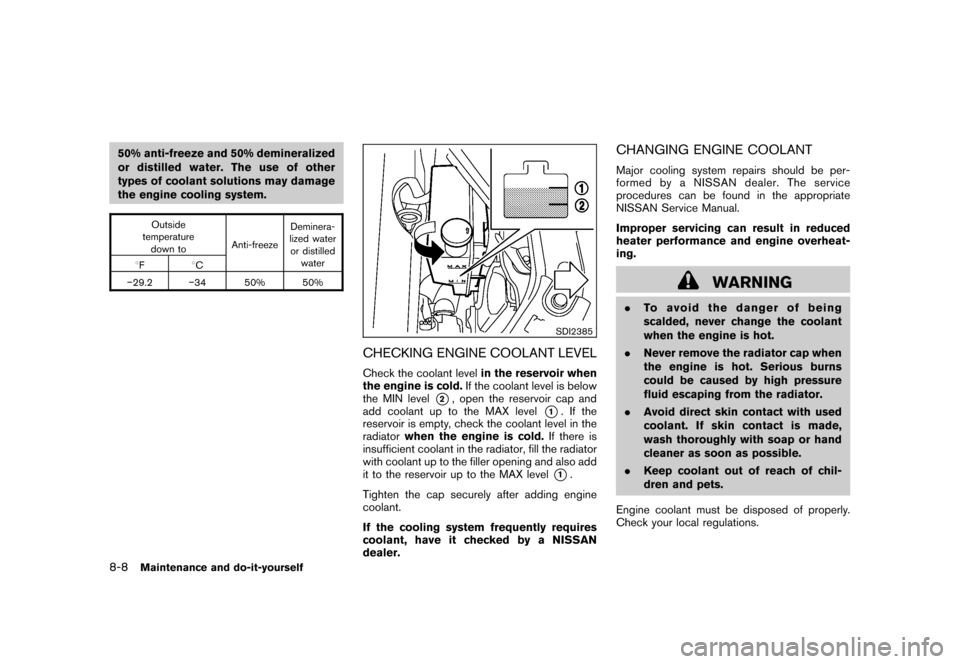
Black plate (270,1)
Model "Z12-D" EDITED: 2009/ 9/ 17
50% anti-freeze and 50% demineralized
or distilled water. The use of other
types of coolant solutions may damage
the engine cooling system.
Outside
temperature down to Anti-freezeDeminera-
lized water
or distilled water
8 F 8C
� 29.2 �34 50%
50%
SDI2385
CHECKING ENGINE COOLANT LEVELCheck the coolant levelin the reservoir when
the engine is cold. If the coolant level is below
the MIN level
*2, open the reservoir cap and
add coolant up to the MAX level
*1. If the
reservoir is empty, check the coolant level in the
radiator when the engine is cold. If there is
insufficient coolant in the radiator, fill the radiator
with coolant up to the filler opening and also add
it to the reservoir up to the MAX level*1.
Tighten the cap securely after adding engine
coolant.
If the cooling system frequently requires
coolant, have it checked by a NISSAN
dealer.
CHANGING ENGINE COOLANTMajor cooling system repairs should be per-
formed by a NISSAN dealer. The service
procedures can be found in the appropriate
NISSAN Service Manual.
Improper servicing can result in reduced
heater performance and engine overheat-
ing.
WARNING
. To avoid the danger of being
scalded, never change the coolant
when the engine is hot.
. Never remove the radiator cap when
the engine is hot. Serious burns
could be caused by high pressure
fluid escaping from the radiator.
. Avoid direct skin contact with used
coolant. If skin contact is made,
wash thoroughly with soap or hand
cleaner as soon as possible.
. Keep coolant out of reach of chil-
dren and pets.
Engine coolant must be disposed of properly.
Check your local regulations.
8-8
Maintenance and do-it-yourself
Page 322 of 329
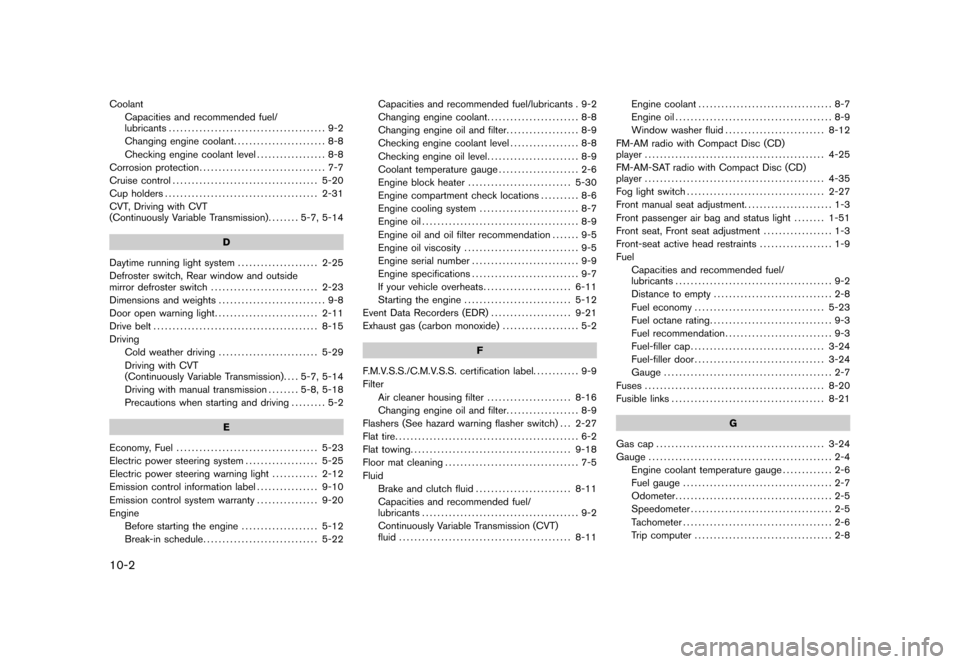
Black plate (2,1)
10-2CoolantCapacities and recommended fuel/
lubricants ......................................... 9-2
Changing engine coolant ........................ 8-8
Checking engine coolant level .................. 8-8
Corrosion protection ................................. 7-7
Cruise control ...................................... 5-20
Cup holders ........................................ 2-31
CVT, Driving with CVT
(Continuously Variable Transmission) ........ 5-7, 5-14
D
Daytime running light system ..................... 2-25
Defroster switch, Rear window and outside
mirror defroster switch ............................ 2-23
Dimensions and weights ............................ 9-8
Door open warning light ........................... 2-11
Drive belt ........................................... 8-15
Driving Cold weather driving .......................... 5-29
Driving with CVT
(Continuously Variable Transmission) .... 5-7, 5-14
Driving with manual transmission ........ 5-8, 5-18
Precautions when starting and driving ......... 5-2
E
Economy, Fuel ..................................... 5-23
Electric power steering system ................... 5-25
Electric power steering warning light ............ 2-12
Emission control information label ................ 9-10
Emission control system warranty ................ 9-20
Engine
Before starting the engine .................... 5-12
Break-in schedule .............................. 5-22 Capacities and recommended fuel/lubricants . 9-2
Changing engine coolant
........................ 8-8
Changing engine oil and filter ................... 8-9
Checking engine coolant level .................. 8-8
Checking engine oil level ........................ 8-9
Coolant temperature gauge ..................... 2-6
Engine block heater ........................... 5-30
Engine compartment check locations .......... 8-6
Engine cooling system .......................... 8-7
Engine oil ......................................... 8-9
Engine oil and oil filter recommendation ....... 9-5
Engine oil viscosity .............................. 9-5
Engine serial number ............................ 9-9
Engine specifications ............................ 9-7
If your vehicle overheats ....................... 6-11
Starting the engine ............................ 5-12
Event Data Recorders (EDR) ..................... 9-21
Exhaust gas (carbon monoxide) .................... 5-2
F
F.M.V.S.S./C.M.V.S.S. certification label. ........... 9-9
Filter Air cleaner housing filter ...................... 8-16
Changing engine oil and filter ................... 8-9
Flashers (See hazard warning flasher switch) . . . 2-27
Flat tire ................................................ 6-2
Flat towing .......................................... 9-18
Floor mat cleaning ................................... 7-5
Fluid Brake and clutch fluid ......................... 8-11
Capacities and recommended fuel/
lubricants ......................................... 9-2
Continuously Variable Transmission (CVT)
fluid ............................................. 8-11 Engine coolant
................................... 8-7
Engine oil ......................................... 8-9
Window washer fluid .......................... 8-12
FM-AM radio with Compact Disc (CD)
player ............................................... 4-25
FM-AM-SAT radio with Compact Disc (CD)
player ............................................... 4-35
Fog light switch .................................... 2-27
Front manual seat adjustment. ...................... 1-3
Front passenger air bag and status light ........ 1-51
Front seat, Front seat adjustment .................. 1-3
Front-seat active head restraints ................... 1-9
Fuel Capacities and recommended fuel/
lubricants ......................................... 9-2
Distance to empty ............................... 2-8
Fuel economy .................................. 5-23
Fuel octane rating ................................ 9-3
Fuel recommendation ............................ 9-3
Fuel-filler cap ................................... 3-24
Fuel-filler door .................................. 3-24
Gauge ............................................ 2-7
Fuses ............................................... 8-20
Fusible links ........................................ 8-21
G
Gas cap ............................................ 3-24
Gauge ................................................ 2-4
Engine coolant temperature gauge ............. 2-6
Fuel gauge ....................................... 2-7
Odometer ......................................... 2-5
Speedometer ..................................... 2-5
Tachometer ....................................... 2-6
Trip computer .................................... 2-8
Model "Z12-D" EDITED: 2010/ 4/ 14
Page 323 of 329

Black plate (3,1)
General maintenance................................ 8-2
Glove box. .......................................... 2-33
H
Hands-Free Phone System, Bluetooth
®.......... 4-44
Hazard warning flasher switch .................... 2-27
Head restraints ....................................... 1-6
Headlights Bulb replacement .............................. 8-26
Headlight switch ............................... 2-23
Heater Engine block heater ........................... 5-30
Heater and air conditioner operation ........... 4-6
Hood release ....................................... 3-21
Hook Luggage hook .................................. 2-34
Utility hooks .................................... 2-35
Horn ................................................ 2-28
I
Ignition switch (with Intelligent Key system) .................... 5-9
(without Intelligent Key system) ................. 5-7
Key positions ..................................... 5-8
Immobilizer system ................................. 2-19
In-cabin microfilter ................................. 4-12
Indicator lights ..................................... 2-15
Inside mirror ........................................ 3-26
Inspection/maintenance (I/M) test ................ 9-21
Instrument brightness control ..................... 2-26
Instrument panel ..................................... 2-3
Intelligent Key system ............................. 3-10
Intelligent Key system warning light .......... 2-12Key operating range
........................... 3-12
Key operation .................................. 3-13
P position selecting warning light ............ 2-14
Remote keyless operation ..................... 3-17
Interior light replacement .......................... 8-27
Interior lights ....................................... 2-38
iPod
®connecting .................................. 4-33
iPod®player operation ............................. 4-39
ISOFIX child restraint .............................. 1-24
J
Jump starting ......................................... 6-8
K
Keyless entry (See remote keyless entry system) ............. 3-6
With Intelligent Key system
(See Intelligent Key system) .................. 3-17
Keys................................................... 3-2 For Intelligent Key system ..................... 3-10
L
Labels Air bag warning labels ......................... 1-57
Air conditioner specification label ............ 9-10
Emission control information label ............ 9-10
Engine serial number ............................ 9-9
F.M.V.S.S./C.M.V.S.S. certification label. ....... 9-9
Tire and Loading information label .... 8-30, 9-10
Vehicle identification number (VIN) ............. 9-8
LATCH system ..................................... 1-24
License plate, Installing front license plate. ...... 9-11Light
Air bag warning light .......................... 1-57
Bulb replacement .............................. 8-25
Cargo light ..................................... 2-40
Ceiling light ..................................... 2-39
Fog light switch ................................ 2-27
Headlight switch ............................... 2-23
Headlights bulb replacement ................. 8-26
Indicator lights ................................. 2-15
Interior lights ................................... 2-38
Map lights ...................................... 2-38
Replacement ................................... 8-25
Warning/indicator lights and audible
reminders ....................................... 2-10
Lights, Exterior and interior light replacement . . . 8-27
Loading information
(See vehicle loading information) ................. 9-14
Lock Automatic door locks ............................ 3-5
Back door lock ................................. 3-22
Door locks ........................................ 3-4
Power door lock ................................. 3-4
Low fuel warning light ............................. 2-12
Low tire pressure warning light ................... 2-13
Low tire pressure warning system (See tire
pressure monitoring system (TPMS)) .............. 5-3
Luggage hooks ..................................... 2-34
M
Maintenance Battery .......................................... 8-13
General maintenance ...................... 8-2, 8-2
Inside the vehicle ................................ 8-3
Maintenance precautions ........................ 8-5
10-3
Model "Z12-D" EDITED: 2009/ 9/ 17